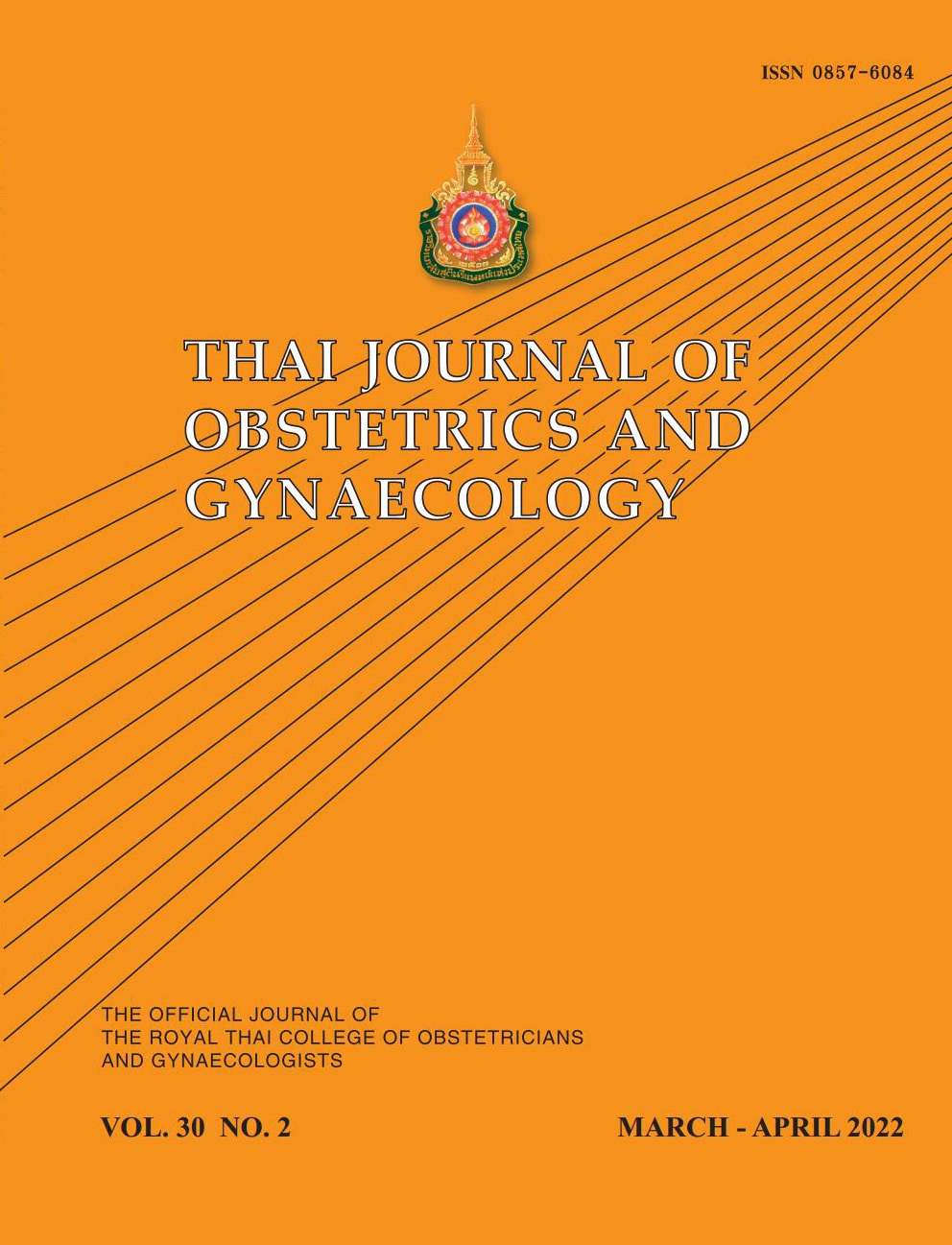Hot Patch Applied to the Lower Back for Pain Relief during the Active Phase of the First-stage Labor: A randomized controlled trial
Main Article Content
Abstract
Objectives: To determine the efficacy of hot patch for pain relief during the active phase of the first stage labor.
Materials and Methods: Fifty-eight singleton pregnant women undergoing normal delivery at Khon Kaen Hospital between February 5 and May 30, 2020, were randomly assigned into two groups: hot patch and standard care. The hot patch was applied to the lower back (dermatome T10 to L1) when cervix dilatation reached 4-6 cm until fully dilated. Pain scores were recorded before hot patch application and every hour until the end of the first stage labor.
Results: Baseline characteristics were not significantly different between groups (p > 0.2). The mean pain score of the hot patch group was significantly less than the control group at 1, 2, 3, 4, and 5 hours after intervention (4.4 ± 1.9 vs. 6.4 ± 1.8, 5.6 ± 2.2 vs. 7.4 ± 1.3, 5.4 ± 1.8 vs. 8.1 ± 0.8, 5.7 ± 2.2 vs. 8.4 ± 0.7, 8.0 ± 0.0 vs. 8.7 ± 0.5, p < 0.001, respectively). The mean duration of the active phase of the first stage labor in the hot patch group was significantly < 0.001). There was no adverse event found.
Conclusion: A hot patch applied to the lower back significantly reduced labor pain during the first stage labor.
Article Details

This work is licensed under a Creative Commons Attribution-NonCommercial-NoDerivatives 4.0 International License.
References
Declercq ER, Sakala C, Corry MP, Applebaum S, Herrlich A. Major survey findings of listening to mothers SM III: pregnancy and birth. J Perinat Educ 2014;23:9-16.
Labor S, Maguire S. The pain of labour. Rev Pain 2008;2:15-9.
Cunningham FG, Leveno KJ, Bloom SL, Dashe JS, Hoffman BL, Casey BM, et al, editors. Williams obstetrics. 25th ed. New York: McGraw-Hill 2018:487.
Anim-Somuah M, Smyth R, Jones L. Epidural versus non-epidural or no analgesia in labour. Cochrane Database Syst Rev 2018;5:CD000331.
Smith CA, Levett KM, Collins CT, Dahlen HG, Ee CC, Suganuma M. Massage, reflexology and other manual methods for pain management in labour. Cochrane Database Syst Rev 2018;3:CD009290.
Simkin P, Bolding A. Update on nonpharmacologic approaches to relieve labor pain and prevent suffering. J Midwifery Women Health 2004;49:489-504.
Rowlands S, Permezel M. Physiology of pain in labour. Baillieres Clin Obstet Gynaecol 1998;12:347-62.
Habanananda T. Non-pharmacological pain relief in labour. J Med Assoc Thai 2004;87:S194-202.
Behmanesh F, Pasha H, Zeinalzadeh M. The effect of heat therapy on labor pain severity and delivery outcome in parturient women. Iran Red Crescent Med J 2009;11:188-92.
Khamis Y, Shaala S, Damarawy H, Romia A, Toppozada M. Effect of heat on uterine contractions during normal labor. Int J Gynaecol Obstet 1983;21:491-3.
Bender T, Nagy G, Barna I, Tefner I, Kadas E, Geher P. The effect of physical therapy on beta-endorphin levels. Eur J Appl Physiol 2007;100:371-82.
Kuhtz-Buschbeck JP, Andresen W, Gobel S, Gilster R, Stick C. Thermoreception and nociception of the skin: a classic paper of Bessou and Perl and analyses of thermal sensitivity during a student laboratory exercise. Adv Physiol Educ 2010;34:25-34.
Poonperm R. Warm compression for pain relief during first stage of labor. J Royal Thai Army Nurses 2014;15: 23-7.
Jessying.com. review & give away : AMMELTZ YOKO YOKO heat patch for menstrual pain a non-medicated solution to period pain[Internet].2015. [cited 2019 Oct 20]. Available from:http://www.jessying.com/2015/03/review-giveaway-ammeltz-yoko-yoko-heat.html
Geissbuehler V, Stein S, EberhardJ. Waterbirths compared with land-births: an observational study ofnine years. J Perinat Med 2004;32:308-14.
Grodzka M, Makowska P, Wielgos M, Przybos A, Chrostowska J, Marianowski L. Water birth in the parturients’ estimation. Ginekol Pol 2001;72:1025-30.
Lenstrup C, Schantz A, Berget A, Feder E, Roseno H, Hertel J. Warm tub bath during delivery. Acta Obstet Gynecol Scand 1987;66:709-12.
Lee SL, Liu CY, Lu YY, Gau ML. Efficacy of warm showers on labor pain and birth experiences during the first labor stage. J Obst Gynecol Neonat Nurs 2013;42:19-28.
Taavoni S, Abdolahian S, Haghani H. Effect of sacrum perineum heat therapy on active phase labor pain and client satisfaction: a randomized, controlled trial study. Pain Med 2013;14:1301-6.
Shirvani MA, Ganji J. The influence of cold pack on labour pain relief and birth outcomes: a randomised controlledtrial. J Clin Nurs 2014;23:2473-80.
Ganji Z, Shirvani MA, Rezaei-Abhari F, Danesh M. The effect of intermittent local heat and cold on labor pain and child birth outcome. Iran J Nurs Midwifery Res 2013;18:298-303.
Adams ED, Bianchi AL. A practical approach to labor support. J Obstet Gynecol Neonatal Nurs 2008;37:106-15.
Lane E, Latham T. Managing pain using heat and cold therapy: Elaine Lane and TracyLatham discuss the benefits of using non-pharmacological interventions to help improvechildren’s experience of pain in hospital settings. Pediatr Nurs 2009;21:14-8.
Vermelis JM, Wassen MM, Fiddelers AA, Nijhuis JG, Marcus MA. Prevalence andpredictors of chronic pain after labor and delivery. Curr Opin Anesthesiol 2010;23:295-9.
Chaichian S, Akhlaghi A, Rousta F, Safavi M. Experience of water birth delivery in Iran. Arch Iran Med 2009;12: 468-71.
Mollamahmutoglu L, Moraloglu O, Ozyer S, Su FA, Karayalcin R, Hancerlioglu N, et al. The effects of immersion in water on labor, birth and newborn and comparison with epiduralanalgesia and conventional vaginal delivery. J Turk Ger Gynecol Assoc 2012;13:45.


